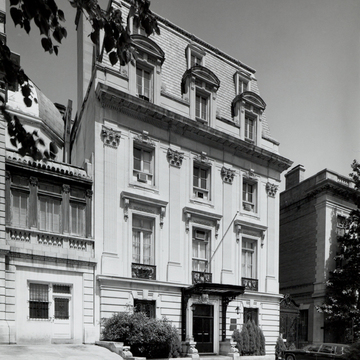You are here
Embassy and Chancery of Haiti
The adjoining Fahnestock and Moran houses were under construction simultaneously and succinctly exhibit two basic approaches to high-style Beaux-Arts architecture in America. Both depend upon eighteenth-century French prototypes; Totten's Moran House is a freely composed, eclectic design while Wyeth's Fahnestock House is more academically correct in its composition and architectural vocabulary. Its four-and-a-half-story limestone facade is a finely proportioned composition in which the richness implied by the Corinthian pilasters is achieved by restrained elegance rather than by abundant ornament. Nonetheless the comparatively thin front plane is activated across its entire surface with variously proportioned and detailed windows locked into a subtly defined and perfectly balanced grid. Although less imaginative than its adjoining neighbor, Wyeth's design is visually coherent and viscerally satisfying, its restraint a positive influence on the avenue.
Writing Credits
If SAH Archipedia has been useful to you, please consider supporting it.
SAH Archipedia tells the story of the United States through its buildings, landscapes, and cities. This freely available resource empowers the public with authoritative knowledge that deepens their understanding and appreciation of the built environment. But the Society of Architectural Historians, which created SAH Archipedia with University of Virginia Press, needs your support to maintain the high-caliber research, writing, photography, cartography, editing, design, and programming that make SAH Archipedia a trusted online resource available to all who value the history of place, heritage tourism, and learning.














